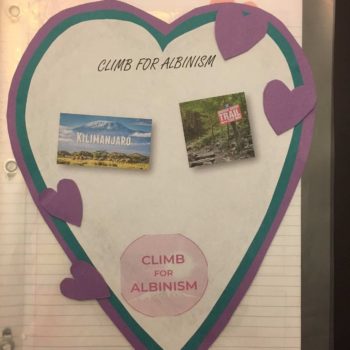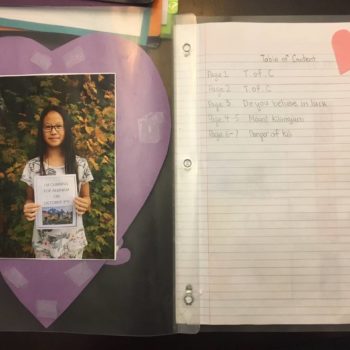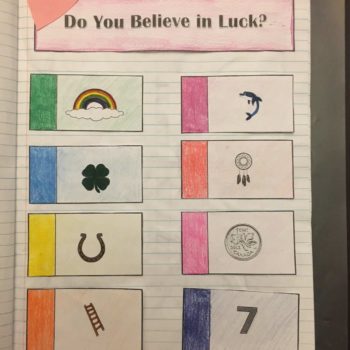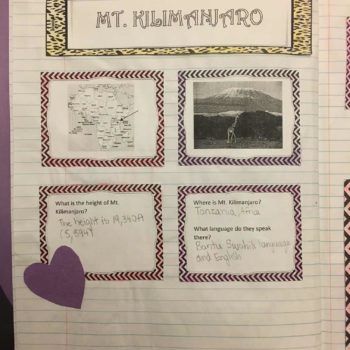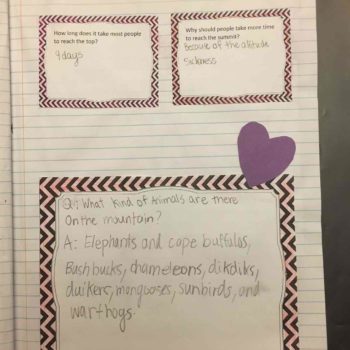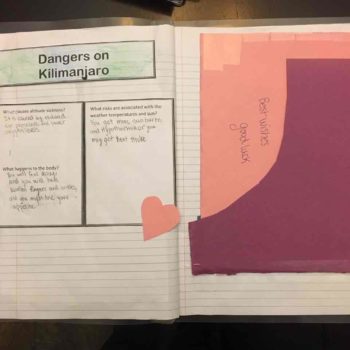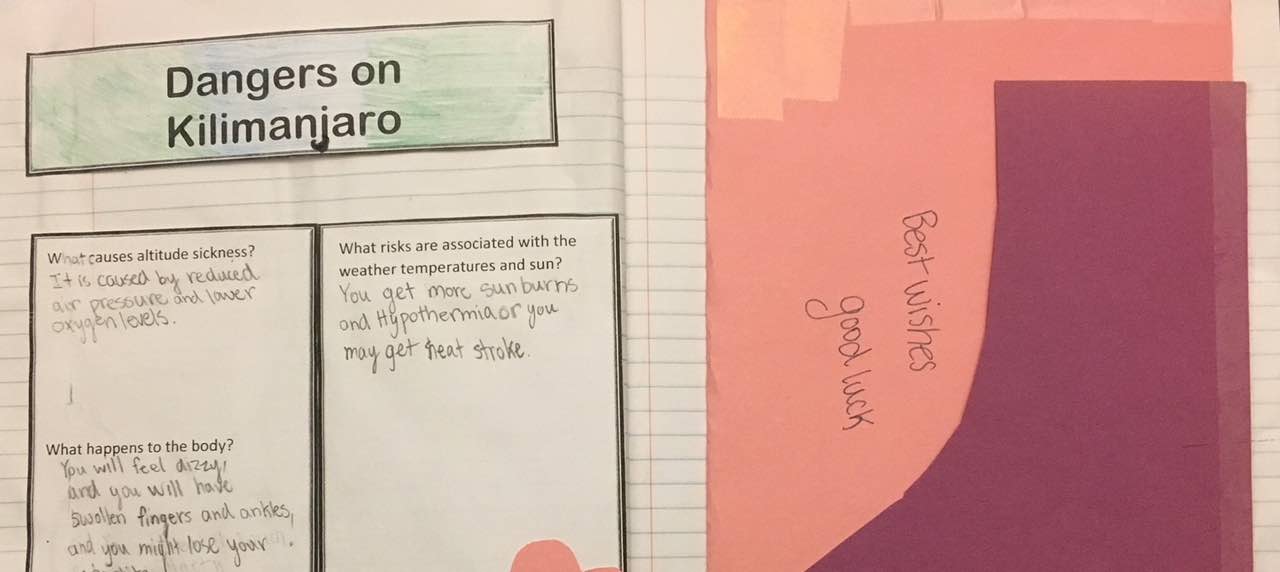
Teacher Instructions:
I will have students put the handouts that I’ve created in their interactive notebook (use a composition notebook or duotang with paper in it). If you haven’t done an interactive notebook before, students can glue things in, create flaps and pouches, and personalize it with pictures and colour. I will have my students create a cover for their notebook, with a title and picture (using a computer or by drawing). I’m going to have my students label theirs with “Climb for Albinism”, but you can also use “Climbology.” On the inside of the front cover of the notebook, my students will glue photos of themselves holding signs saying, “I’m climbing for albinism on (insert date of climb).” Hopefully, the final product will be something they are proud of.
Mapping assignments, letters, postcards, and journal reflections can go in the interactive notebook.
Cover ideas
Inside notebook ideas
Next have students set up a table of contents so that it’s organized, and number every page in the book.
The following are suggested pages. Adjust the numbers if you decide to add journal reflections, letters or other items.
Page One: Do You Believe in Luck?
This is an introduction to the albinism issue. People in many African countries have been told by witchdoctors that the body parts of people with albinism have magical properties and will bring luck. After students explore the beliefs about luck that have existed through the ages and around the world, you can discuss with them their own beliefs about luck, and you can introduce the issues that people with albinism face because of what the people living around them believe. Your students may hear or see the term ‘albino’ while exploring these issues. However, I always try to say ‘person with albinism’ so that we can emphasize that they are people. While this is a sensitive topic because of the violence, I have dealt with this issue with students ranging in age from grade 6 to 8 and have found them interested and engaged. There is nothing that young people hate more than injustice and this situation is wrought with injustice. It helps them develop empathy and an interest in global issues. Parents have also been very supportive and engaged.
This is meant to be the first page in their Climb for Albinism notebook. They should cut out all the boxes, including the title, and glue them onto page one of their notebooks. Have them fill in the table of contents and write page numbers on each page. The line on the left of each box is to show where the fold goes to create a moving flap. Glue underneath on the left to secure to the page. I prefer liquid white glue as it lasts forever, but I tell my students to only use a few “baby dots,” or they get carried away and use way too much glue. Then they can find out what each symbol means by browsing on the web. There is a lot of information that is very easy to find. They only have a small space to write so they’ll need to pull out the important details and summarize. They will not be able to copy everything they read.
This is a good short video from ABC’s 20/20 that explains the issue.
At this time, I suggest introducing your students to the Mt. Kilimanjaro climb. I introduced my students by showing them a video of Elia when he was young, because we would be going on the journey/adventure with him. I wanted the kids to feel like they knew Elia and that he was a friend taking them on this great adventure.
Page Two – Three: Mt. Kilimanjaro
This involves answering questions, cutting and gluing. Again, I recommend reminding students to use ‘baby dots’ when gluing so they don’t make a mess. They can also add colour to their borders if they want to as well (best to do this before cutting and gluing).
Page Four – Five: Dangers on Mt. Kilimanjaro
Students will learn about altitude sickness and the dangers with the sun and temperature changes on the mountain. There is a website that will help them find this information. Then review or teach students how to format a letter. Students will write a letter to one of the ladies doing the climb, offering advice, warning, and words of encouragement. They can create a folder on page five to put their letter in or you can give them an envelope to glue into their notebook, with the letter inside.
Page Six: Calories in! Calories out!
Students will complete tasks on sheet, cut out boxes and glue into notebook. Again they can add colour if they want to.
Biographies/Geographies:
This section will help students learn about the people involved in the climb and about each of their home countries in Africa. The purpose of each biography assignment is to introduce students to each of the climbers, to develop empathy and hopefully create a personal investment in their success on Kilimanjaro.
Page Seven: Elia Sakaily
I decided to start with a biography on Elia Saikaly, because on his own, Elia is fascinating and engaging. He has overcome a lot of challenges in his life to become very successful and a great humanitarian. He is a great role model for young people.
I’m going to ask students to create a folder in their notebook using construction paper and then put this handout in the folder. You could also give them the option of cutting out the boxes and gluing them in.
Page Eight: Maah Keita
Maah is from Senegal and her band, Takeifa is very successful, travelling around Africa and Europe to perform.
Page Nine – Ten: Senegal
Page Eleven: Dr. Edi
Page Twelve – Thirteen: Nigeria
Page Fourteen: Regina Mary
Page Fifteen – Sixteen: South Africa
Page Seventeen: Jane Waithera
There are many youtube video’s featuring Jane. She is active in changing perceptions about people with albinism and in creating change, especially for women and girls with albinism. She has many inspiring words you can discuss with your students – ‘love yourself for who you are,’ and ‘change how you see, see how you change.’ These would be good journal prompts.
Page Eighteen – Nineteen: Kenya
Page Twenty: Mariam Stafford
There are many articles and video’s on Mariam. After her 2008 attack she became the face of the albinism issue because she miraculously survived the attack where she lost both her arms. Even though she was able to identify her attackers (one was her neighbour), neither ever faced justice. Having met Mariam, I can tell you that she is very genuine and is truly a role model for her resilience and positivity.
Page Twenty-One – Twenty-Two: Tanzania
Page Twenty-Three: Congratulations Team!
Write a congratulations letter to the climb team. Tell them about your own success doing the climb for albinism (if you did a climb in their honour). Share your experience and what you gained from watching their climb on Kilimanjaro. What do you wish for them in the future? What lessons will you take with you? How will this experience help shape your future self?
Suggested Journal topics: Insert journal entries throughout. Adjust page numbers to do so. Watch the webinars from the Climb for Albinism and have students write a summary and reflection. Challenge them to make connections. Ideas:
Why is this important? What does Elia hope to accomplish? What challenges have these ladies faced in the past? How does this compare to the challenges they’re facing on the mountain? What challenges have you faced? In what ways has discrimination effected your life? They should be striving to make connections, to ask questions and try to imagine how the climbers are feeling on the mountain.
